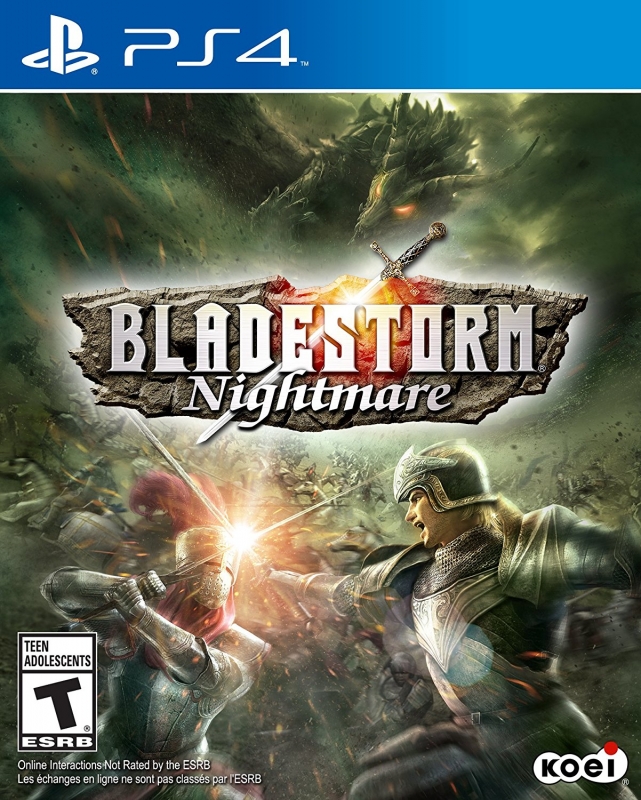
Bladestorm: Nightmare (PS4) - Review
by Jake Weston , posted on 22 March 2015 / 7,430 ViewsBladestorm: Nightmare is theoretically a good idea on paper. Take 2007’s Bladestorm: The Hundred Years’ War - the hack ‘n’ slash-meets-RTS cult adaptation of the historical conflict of the same name - and update it for the new generation of consoles while also including a new “Nightmare” campaign, following up on the events of the game while adding more fantastical elements such as magic and mythical monsters.
With its unique core gameplay and intriguing reimagining of history, Bladestorm: Nightmare is definitely a concept I can get behind. Unfortunately, the monotonous gameplay and technical issues present in the original game have followed it over to the next generation.
To its credit, Bladestorm: Nightmare starts off strong. You play as a mercenary, neutral in the decades-long conflict between the French and the English, hoping to make gains from the war. After making my mercenary in an impressively robust character creation system, I was thrown into battle. Unlike Koei Tecmo’s sister series Dynasty Warriors, you are not a lone warrior tasked with taking down dozens of enemy soldiers with each blow. In fact, mercenaries are rather weak on their own, and instead must take command of various squads of soldiers dispersed throughout the battlefield in order to make an impact on the battlefield.
Each of these squadrons has different abilities - lead a cavalry of horse-mounted soldiers into the heart of the enemy, get up close and personal with various close-quarters units, or fire from afar with a legion of archers. You directly control your units’ attacks - hold down R1 for them to continuously attack, or press the face buttons for a myriad of special attacks.
There are dozens of different unit types at your disposal in Bladestorm, but your enemy has access to them as well. There’s a rock-paper-scissors element to skirmishes in Bladestorm, with certain enemy types being more effective against others and vice-versa. For example, a squad of spear-wielders are next to useless against cavalry, but are massively effective against swordsmen. Early on you’ll have to take control of a variety of different enemy types to win battles, although increased usage of a squad type results in them leveling up and becoming stronger, granting them greater usefulness across situations.
As stated earlier, all of these ideas are interesting conceptually. Unfortunately, it never quite translates into engaging gameplay. Ultimately, the vast majority of the game boils down running across battlefields, seeing your unit type is weak against the enemy’s, then doubling back to get the proper unit. Then you come back, and mash your units against the enemies until they’re all dead. Maps are huge, so this process can often take a while, and grows increasingly tiresome as the objectives carry little variety across the lengthy campaign.
The new feature of being to instantly change between up to four different mercenaries across the battlefield somewhat alleviates this issue at least, and indeed when the game is firing on all cylinders, zapping between your four commanders and clashing all the various enemy units against each other can get quite fun in a basic, visceral way.
Although Bladestorm’s campaign exists in the heightened yet still overall grounded reality of the Hundred Years’ War conflicts, the new “Nightmare” mode is anything but. Taking place after the events of the original game, Joan of Arc has stumbled across a mysterious power, giving her control of an army of demons, forcing England and France to set aside their differences to combat the new threat. With its fantasy approach to the story, Nightmare also brings appropriate new fantastical troop types, such as undead skeletons, goblins, and dragons. These new enemy units help bring variety to the package, but ultimately the core gameplay still suffers from the same monotony that tempered the original release.
Bladestorm arrived early in the PlayStation 3 and Xbox 360 generation, and the game certainly looks like it. That’s not to hold this against the developers, who used the current generation’s increased horsepower to increase the game’s resolution, and it’s interesting to play this game just to see how far game graphics have come. Unfortunately, the improved console specs did not aid in other technological departments of the game. Pop-in for enemy soldiers and trees is a common occurrence, and the framerate frequently drops when large amounts of enemies are on screen. Considering the game’s massive battles are kind of the *point*, this is definitely unfortunate.
Bladestorm: Nightmare has neat ideas, but it’s tough to recommend to newcomers. Those who enjoyed Bladestorm: The Hundred Years’ War upon its original release may be interested in revisiting it on new hardware, and depending on which version you purchase you can even transfer your content from the original 2007 release over (pretty impressive for an eight year old console game). There’s lots to appreciate about Bladestorm: Nightmare, with only its drawn-out gameplay and technical issues holding it back. Until those are worked out, perhaps this series is destined to remain with simply cult appeal.
VGChartz Verdict
6
Decent
This review is based on a retail copy of Bladestorm: Nightmare for the PS4, provided by the publisher.


























